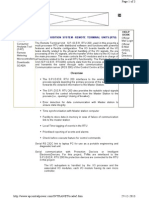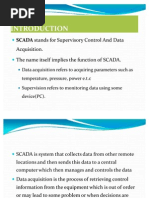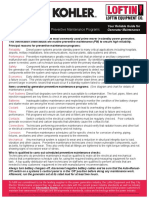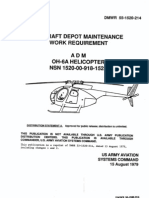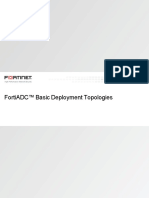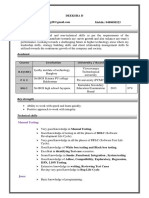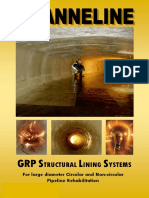Chapter 2
Chapter 2
Uploaded by
Raghav GhateCopyright:
Available Formats
Chapter 2
Chapter 2
Uploaded by
Raghav GhateOriginal Description:
Copyright
Available Formats
Share this document
Did you find this document useful?
Is this content inappropriate?
Copyright:
Available Formats
Chapter 2
Chapter 2
Uploaded by
Raghav GhateCopyright:
Available Formats
Chapter 2
FUNCTIONS OF
SUPERVISORY CONTROL & DATA ACQUISITION (SCADA) SYSTEM
Dr. H.K. VERMA
Distinguished Professor
Department of Electrical and Electronics Engineering
School of Engineering and Technology
SHARDA UNIVERSITY
Greater Noida, India
website:
profhkverma.info
1. Introduction
Before we can identify and discuss the functions of SCADA system, let us briefly overview
the layout, working and components of a SCADA system, which were dealt with in detail in
Chapter-1 on Basics of SCADA:
1.1 Overview
As illustrated in figure 1 below, the controlled process/ plant is notionally partitioned for the
purpose of monitoring and control into certain sections. A small microprocessor-based unit,
called remote terminal unit or RTU, is placed in and interfaced to each section of the plant. There
is a large computer-based central supervisory unit, or the control and monitoring unit, called
master terminal unit (MTU) or master station or supervisory station. It is located in a central or
strategic place, called control room. Each RTU is expected to acquire data (analog values of
controlled variables and status information of remote and locally controlled objects) from the
plant section assigned to this particular RTU and to transmit data to the MTU after necessary
processing of the acquired data. Likewise, each RTU expects to receive control instructions
(relevant to the plant section assigned to it) from the MTU and deliver them to the plant. This
two-way digital communication between RTUs and MTU is carried out on the so-called MTURTU communication sub-system.
The RTU acquires analog values and status information through sensors and status sensors,
respectively. Similarly, it delivers the set points and discrete control commands to automatic
controllers and actuators, respectively. These devices thus act as the interface between the RTU
and the controlled plant. Being located in the field (within the plant), these devices are known as
field devices (FDs). The electrical communication system linking the field devices to the RTU is
called the RTU-FD communication sub-system. Thus, a SCADA system is broadly comprised of
the following five components:
(i) Remote terminal units (RTUs)
(ii) Master terminal unit (MTU)
(iii)MTU-RTU communication subsystem
(iv) Field devices (FDs)
(v) RTU-FD communication subsystem.
1.2 Functions
A supervisory control and data acquisition (SCADA) system performs the following major
functions:
(i)
Human-machine interface (HMI)
(ii) Electrical communication
(iii) Data acquisition (DAQ)
(iv) Monitoring
(v) Control
(vi) Data collection, storage and retrieval
(vii) Calculation
2
(viii) Report generation
Various functions of SCADA system are now described one-by-one in detail in the following
sections.
2. Human-Machine Interface (HMI)
2.1 What is HMI?
The SCADA system is designed to monitor and control the process/ plant automatically most
of the time. However, for various reasons provisions are made for human operators to
continuously watch its operation and to intervene as and when felt necessary by them. This
requires an interface between the SCADA system and the human operators. The same is
provided as a standard practice in the MTU located in the control room. The MTU is built and
functions around a computer. Therefore, the human-SCADA interface is realised through
human-computer interface, commonly known as human-machine interface (HMI) and
sometimes as graphic operator interface (GOI).
2.2 Role of HMI
The human-machine interface (HMI) enables the operator:
(a) to watch the process/plant being monitored and controlled by SCADA system, and
(b) to intervene as and when considered necessary by him.
2.3 What Does HMI Comprise?
In order to perform the above role, the HMI comprises suitable hardware (input/output
devices or computer peripherals as discussed below) and the related software drivers (or datatransfer software):
A. Input Devices for HMI: The input device almost always used for HMI is the standard
(ASCII) keyboard, one on each operator console. The operator can use it for entering (a)
data and (b) instructions for intervention in the computer control.
B. Output Devices for HMI: The following output devices are used for HMI:
(i) The mostly used output device is the video monitor or video display unit (VDU) along
with a mouse, one monitor-mouse pair on each operator console. Colour LCD monitors
are now preferred to achieve a better visual impact in presenting status, events, alarms
and trends to the operator.
3
(ii) Very often, a speaker or buzzer is also provided on the operator console for issuing
audio alerts and audio alarms to the operator.
(iii) A large wall-mounted high-definition LED screen is used for displaying boldly a singleline diagram (SLD) of the process flow, called as mimic diagram or simply mimic, and
the screen is traditionally known as mimic board. The purpose of the mimic is to present
at-a-glance picture or overview of the complete process to the operators. It can be either
static or dynamic. A static mimic displays only a static SLD of the process, whereas a
dynamic mimic displays the real-time status of major objects in the plant and the current
measured values of important variables, both laid over the SLD of the process.
(iv) One or more printers are included for generating hard copy of (a) programs, (b) screen
shots, and (c) reports.
(v) The HMI of the earlier SCADA systems used to incorporate a plotter as well for
generating hard copy of trend curves, graphs and drawings. With the advent of highresolution low-cost printers, the plotters have become obsolete.
3. Electrical communication
Electrical communication is required:
(a) Between the MTU and each RTU, and
(b) Between each RTU and the field devices connected to it.
Details of these communications are described below.
3.1 MTU-RTU Communication
Each RTU is expected to acquire data (analog values of important variables and status
information of important objects) from the plant section assigned to this particular RTU and to
transmit data to the MTU after necessary processing of the acquired data. Likewise, each RTU
expects to receive control instructions (relevant to the plant section assigned to it) from the MTU
and deliver them to the plant. This necessitates two-way (or duplex) digital communication
between RTUs and the MTU.
There is no need of providing individual point-to-point communication links between each
RTU and the MTU. Such an arrangement would require the MTU to have one transceiver
(transmitter + receiver) per RTU and the total length of communication cables would also be
very large. This would make the cost of MTU-RTU communication subsystem very high and its
performance and reliability very poor. A much better option, which is now commonly used, is to
provide/ use a single data network linking all the RTUs with the MTU. However, depending on
the geographic size of the controlled process and dispersion of its facilities, the data network may
be a LAN (local area network), MAN (metropolitan area network) or WAN (wide area network).
4
For a public utility spread over a nation or beyond, even the Internet may be used for data
communication between the MTU and the RTUs, subject to data security considerations.
3.2 RTU-Field Device Communication
Each RTU acquires the analog values of controlled and uncontrolled variables of the process
through analog sensors and the status information from remotely and locally controlled objects in
the plant using status sensors. Similarly, it delivers the set points to automatic or feedback
controllers (of the controlled variables) and discrete control commands to various actuators (of
the remotely controlled objects). Thus these devices (analog and status sensors, feedback
controllers and actuators), known as field devices, act as the interface between the RTU and the
controlled process/ plant. The following important points should be noted in regard to the
communication between an RTU and the related field devices:
(a) The communication between simple (non-smart) field devices and RTU is in one direction
only or simplex, as against an essential duplex communication between RTUs and MTU. To
clarify the point further, the information or signal has to travel only from non-smart sensors
to the RTU, but not from RTU to the sensors. Similarly, the information to the unintelligent
controllers and actuators has to come from RTU and no information or signal goes from
these devices to the RTU.
(b) The status information going from the status sensors to the RTU and the control commands
delivered by the RTU to the actuators, both, are essentially discrete (or binary) in nature.
These are sent using binary signals (high/low or 1/0 signals).
(c) The information going from the analog sensors to the RTU is analog in nature. This analog
information is either transmitted as such to the RTU using analog communication (4-20 mA
is the most widely used analog signal) or is first converted to digital value using an analogto-digital converter (ADC) and then transmitted using digital communication techniques.
(d) The set points received by the RTU from the MTU are always digital in nature, because
RTU-MTU communication is always digital. The RTU can deliver it in digital form itself
using digital communication, provided the automatic controller receiving it is also of digital
type. But if the controller is of analog type, the RTU will convert it to analog value (4-20 mA
most likely) using a digital-to-analog converter (DAC) and send this analog signal to the
controller.
(e) Lastly, if smart or intelligent field devices are used, then a two-way digital communication
will be required between them and the RTU. In fact, a local area network (LAN) can be set
up for the communication between such field devices and the RTU, with the attendant
benefits of lower cost, reduced wiring/cabling and higher reliability.
5
4. Data Acquisition (DAQ)
Data are acquired and processed by RTUs and transmitted to MTU on the MTU-RTU data
network.
4.1 What Data are Acquired?
As briefly mentioned under the review of SCADA system, two types of data are continuously
acquired by the RTU:
(a) Analog Values: Values of the uncontrolled as well as controlled variables, which are
almost always analog in nature, are acquired continuously using suitable analog sensors
(or transducers), signal conditioners and a microprocessor-based data acquisition circuit.
The sensors are naturally placed at the locations where the variables are located. The
signal conditioners may be located close to the sensors or inside the RTU or in front of
the RTU. In the last case, the external signal conditioner processes the electrical signal
coming from a sensor before inputting it to the RTU. In case of a smart sensor, the
signal conditioning circuit is integrated with a micro-sensor in a single chip. Data
acquisition circuit is an internal and important component of the RTU.
(b) Status Information: Information about the states of remotely as well as locally
controlled objects, which is essentially discrete or binary in nature, is also acquired
continuously. This is done using suitable status sensors and a data acquisition circuit.
4.2 When are Data Transmitted?
The data acquired as above is processed in the RTU to extract the information as required by
the MTU. Details of the data processing will be taken up under the calculation function of
RTU. The extracted information (or processed data) is transmitted by the RTU to the MTU on
five occasions:
(i) Periodically at a pre-determined rate (this rate is often different for different data).
(ii) Whenever an event takes place (event means a change larger than a predefined change
from the normal or the previous value of a variable or a change in the state of an object).
(iii) On start-up of the plant or process.
(iv) Whenever the process or plant is restarted.
(v) In response to a demand made by MTU.
5. Monitoring
It is a common practice to monitor (a) status, (b) events, (c) limits and (d) trends. This
function (monitoring) is carried out jointly by RTU and MTU as discussed below.
5.1 Status Monitoring
As one its important functions, the RTU determines the status of two-state objects from the
status information acquired continuously by it (as already discussed under Data Acquisition). It
takes some finite time for the object to change from one stable state to the other stable state.
Thus the object is in an intermediate but unstable state during the change-over. The method of
determining the status should be such that the decision of the RTU is not vitiated by this
intermediate state. Very often, this is achieved by introducing a delay in making the decision,
which is a little more than the operating time of the object. The status of important objects
monitored by the RTU in this way is transmitted by it to the MTU for displaying to the operator
on video monitor.
5.2 Event Monitoring
Generally it is the RTU which is responsible for detecting events and intimating to the MTU.
The RTU compares the current value of a variable against its previous, normal or reference
value. If the change exceeds a predefined increment or decrement, an event is said to have taken
place. Similarly, the RTU compares the current status of an object against the previous, normal
or reference state of that object. If the change is of a predefined type, an event is said to have
occurred. Moreover, the event can be one of the following types:
(i) Instantaneous Event: It means an abrupt change or a change without any intentional
delay. This type of event is communicated at once by the RTU to the MTU.
(ii) Delayed Event: It means a change with an intentional delay. It is communicated by the
RTU only when the change is completed.
(iii) Sequential Event: It means a sequence of activities or changes. This type of event is
communicated by the RTU on the completion of the sequence.
In each case, as and when an intimation of the occurrence / completion of an event is
received by the MTU, it stores the same in its computer memory and annunciates or displays
suitably to the operator on speaker/ buzzer/ video monitor of HMI.
5.3 Limit Monitoring
Four sets of limits are monitored in a well-designed SCADA system:
(i) Reasonability Limits: Every feedback controller is expected to monitor and maintain
the value of the variable controlled by it within a pair of upper and lower limits, called
reasonability limits. In case the value of the variable tends to rise above the upper limit
or fall below the lower limit, the controller take corrective action to keep the value
within the limits.
(ii) Warning Limits: The computer in the MTU monitors critical variables in the process
against certain predefined limits on the basis of the data coming from the RTUs. In case
such a limit is found violated, the computer displays a warning message to the operator
on video monitor. Alternatively, the RTU monitors these variables and, in case of a
violation of limits, communicates this fact to the MTU for warning the operator. The
operator is then expected to intervene and take a planned action before the situation
becomes alarming.
(iii) Alarm Limits: If the operator fails to act on a warning, some critical variables may
cross the farther set of alarm limits. When alarm limits are violated, the computer of the
MTU generates an alarm so that the operator takes an emergency action before the
system becomes unstable or unsafe. An alarm is in the form of sounding a buzzer or
pronouncement on a speaker.
(iv) Safety Limits: In case a certain parameter crosses a predefined limit indicative of
danger to the process, plant or personnel, the concerned RTU or the protection system of
the plant generates a command to shut down a part or whole of the process. Typically,
one or more circuit breakers are tripped by protective relays to shut off power supply to
a part or whole of the process/plant.
5.4 Trend Monitoring
The following trends are generally monitored:
(i) Variation of critical/ important parameters with time , and/ or
(ii) Rate of variation of critical/ important parameters.
These trends usually reveal the working and health of the system much more than do the
absolute values of the system parameters. The trends are calculated in real time by the computer
of the MTU from the data received by it from the RTUs, and are displayed to the operator as
curves on video monitor to enable him to take appropriate action as and when he notices an
abnormal trend.
6. Control
Control instructions (set points and discrete control commands) are sent by MTU to the
RTUs. The set points received by an RTU are delivered by it to the concerned automatic
controllers. The discrete control commands received by an RTU are executed as under:
(a) A simple device control command is delivered by the RTU to the concerned actuator.
(b) When a sequential control command is received by an RTU, it initiates the intended
sequence of actions.
(c) When a regulation command (like raise-lower, or up-down command) is received by
an RTU it is interpreted by the RTU and delivered to the related actuator. For example,
raise command is delivered to the lower terminal of a gate controller for raising a
8
dam gate continuously as long as the raise command continues and lower command
is delivered to the lower terminal of the gate controller for similarly lowering the gate
continuously as long as the lower command is present.
7. Data Collection, Storage and Retrieval
As explained earlier, each RTU acquires certain data from the controlled process/ plant,
processes it appropriately, and then transmits to the MTU at appropriate instants. Some of the
data so received by the MTU is stored in the mass-storage media of the MTU. An operator can
later on retrieve a block of data of his interest from the storage and recreate an event, sequence or
history for visualization and analysis
7.1 Types of Data Stored
Three types of data are stored by the MTU in its mass-storage media:
(a) Disturbance Data: Short duration data, the duration of which ranges typically between a
few seconds to several minutes, is stored for recording a disturbance in the process.
(b) Historical Data: Medium duration data, its duration ranging from a few hours to several
days, is recorded for keeping a history of operation of the process.
(c) Planning Data: Long duration data, recorded typically over a month, a quarter of a year,
one full year, or even a few years, is meant to serve as a vital input for planning.
7.2 Time Stamping of Data
The data received from various RTUs is stored with chronology to recreate a disturbance
event or a historical event. To that end, the individual data must be tagged with the time of its
occurrence, or time-stamped, either at the receiving end (that is by the MTU) or at the
transmitting end (that is by the individual RTUs). Because of variable delays in transmission of
data from different RTUs to the MTU, the first option can distort the sequence of activities
represented by the data. On the other hand, the second option can distort the data if the time
clocks of various RTUs are not synchronized. The best option is synchronize the clocks of all
RTUs and MTU and to time stamp the data at RTUs. If the controlled process is located within
small premises, synchronizing the clocks of all RTUs and MTU becomes a simple task. On the
hand, if the process is spread over a large area (typical in the case of utilities), the time clocks of
all RTUs and MTU are synchronized using GPS (geographical positioning system).
8. Calculation
Calculations are made both in RTUs and MTU. The nature and extent of these calculations
are brought out below:
8.1 Calculations in RTU
The microprocessor of an RTU is required to perform simple calculations or data processing,
such as:
(a) Filtering the data acquired by it to remove noise,
(b) Extraction of desired information, like maximum, minimum, rms or average value or rate
of change, from filtered data,
(c) Conversion of numbers to values in engineering units, and
(d) Compression of data to reduce data-transmission-rate and storage requirements.
8.2 Calculations in MTU
The calculations that need to be made by the computer of the MTU are in general fairly
extensive and complex. These calculations are made for predicting the behavior of the system
(controlled process) through mathematical modeling for certain anticipated conditions and
certain inputs to the system, both for normal and contingency operation. The output of these
calculations is a set control instructions to be sent to different RTUs for each set of system
conditions and inputs. The calculations are usually made on floating-point numbers and in batch
mode.
9. Report Generation
One of the important functions of SCADA software is to generate a vast number of reports
on the basis of the data stored by the MTU. To that end, SCADA software includes a report
generator module, which retrieves data from the MTU database and generates the desired reports
from it. The software module allows the user to choose the format of reports, customize the style
of reports, insert graphics and even perform calculations.
9.1 Purpose of Report Generation
These reports provide an invaluable information support to decision making in:
(a)
(b)
(c)
(d)
Operation of the whole system
Maintenance of the whole system
Management of the business related to the controlled process
Technical and business planning, both short-term and long-term.
10
9.2 Types of Reports
A good report generator (software) is capable of generating the following types of reports.
However, the exact nature, number, format and contents of the reports depend on the users need
and liking and the purpose of such reports.
(a) Status Report: Reflecting the analog values of important variables, states of important
objects, set points, limit settings, etc., at a specified time.
(b) Trend Report: Reflecting the trends of the variation or the rate of variation of certain
selected variables over a specified period.
(c) Event Report or Event Log: A log of the events recorded over a specified period.
(d) Alarm Report or Alarm Log: A log of the alarms generated over a specified period.
(e) Communication Report or Communication Log: A log of the communications taken
place between the MTU and the selected RTUs over a specified period.
(f) Display Printout or Screen Printout: A printout of a selected screen/ display on a VDU.
(g) Operational Reports: Reports on other operational aspects of the system, like a record of
data preceding and following an event or disturbance, energy consumption by different
parts of the process/ system over a specified period, record of production over a specified
period, and so on.
(h) Statistical Reports: Reports showing statistical information or presenting information
based on statistical analysis of the operational data recorded by the MTU.
9.3 When to Generate Reports?
These reports are generated variously on continuous, periodic or on-demand basis as under:
(a) Some of the reports, like status, trend, event or alarm reports, are generated periodically,
for example, every 8, 12 or 24 hours. In addition, reports of the most recent events and
alarms are generated on demand following a disturbance or breakdown in the system.
(b) An earlier practice was to generate continuous logs of events and alarms on a dedicated
printer. This practice resulted in gross wastage of paper and printing ink, as most of the
printed output would never be looked into. The reason for this practice was that the
electronic/ magnetic memories were not considered very reliable or were too expensive.
This practice is now largely obsolete because of the changed condions.
11
(c) Screen printouts are taken occasionally when a need to analyse the data off-line arises,
say, following a major disturbance or breakdown.
(d) Operational and statistical reports are generated at longer intervals, say monthly,
quarterly or annually, to serve as information inputs to management and planning
exercises.
9.4 Where to Generate/ Print a Report?
Various reports are generated/ printed at different places as under:
(a) The reports required to be generated periodically and/or on demand, are generated and
printed in the control room. A printer is included as a part of operators console.
(b) As mentioned earlier, a dedicated printer was earlier used for continuous printing of event
and alarm logs. To avoid printing noise in the control room, such printers were often
placed in a separate (preferably sound-proof) chamber close to the control room.
(c) Statistical reports are usually required by the corporate decision makers. In a typical
modern scenario, corporate servers and computers are connected to the MTU server on a
network (LAN or WAN or Internet). Therefore, statistical reports are generated on the
corporate computers and printed in the concerned corporate department.
(d) Some of the reports may need to be generated by a maintenance engineer to help him in
trouble-shooting. He would generally use a laptop computer to access database of
SCADA system and generate the necessary report by plugging it to the SCADA network.
12
You might also like
- Power Network Control ReportDocument7 pagesPower Network Control ReportTawanda Daniel DenguNo ratings yet
- Spider Rtu DocumentDocument3 pagesSpider Rtu DocumentNeelakandan MasilamaniNo ratings yet
- PLC Topic 3 and 4 NotesDocument61 pagesPLC Topic 3 and 4 Noteshoseah mwanzahNo ratings yet
- SCADA PaperDocument15 pagesSCADA Paperprashantbgpatel1No ratings yet
- PLC Topic Three 5Document95 pagesPLC Topic Three 5hoseah mwanzahNo ratings yet
- Scada IeeeDocument5 pagesScada IeeeVarsha PaiNo ratings yet
- Topic 3Document21 pagesTopic 3hoseah mwanzahNo ratings yet
- SCADADocument26 pagesSCADADr-Amit Kumar SinghNo ratings yet
- What Is SCADA?Document10 pagesWhat Is SCADA?fasihNo ratings yet
- 14237Document19 pages14237Timothy FieldsNo ratings yet
- Iaa Unit 04Document19 pagesIaa Unit 04SurajNo ratings yet
- Iaa Unit 04Document19 pagesIaa Unit 04SurajNo ratings yet
- Scada in Power Distribution Systems SeminarDocument2 pagesScada in Power Distribution Systems Seminarsumitsinha89100% (1)
- Scada - Psa - SGDocument54 pagesScada - Psa - SGaditya naniNo ratings yet
- Scada and Power System AutomationDocument55 pagesScada and Power System AutomationTausique SheikhNo ratings yet
- UNIT 5 Scada-1Document23 pagesUNIT 5 Scada-1amit6200506882No ratings yet
- SCADA - Supervisory Control and Data AcquisitionDocument23 pagesSCADA - Supervisory Control and Data AcquisitionSushant KambojNo ratings yet
- SSDDDDCCCDocument5 pagesSSDDDDCCCdarshan bsNo ratings yet
- Scada Paper1Document8 pagesScada Paper1Edu EdyNo ratings yet
- SCADADocument42 pagesSCADAArunMozhiDevan3No ratings yet
- Lecturenote - 952756569CH 5 ECEG5252 Notes SCADADocument11 pagesLecturenote - 952756569CH 5 ECEG5252 Notes SCADAAla AwoudaNo ratings yet
- Five Terms You MUST Be Familiar With SCADA, DCS, PLC, RTU and Smart Instrument EEPDocument1 pageFive Terms You MUST Be Familiar With SCADA, DCS, PLC, RTU and Smart Instrument EEPwahbaabassNo ratings yet
- Remote Terminal Unit: 2.0 Introduction of RtuDocument3 pagesRemote Terminal Unit: 2.0 Introduction of RtuREDDY SANDEEPNo ratings yet
- Remotes Terminals UnitsDocument14 pagesRemotes Terminals Unitscondorito10No ratings yet
- Presented by Shubham Kapoor 3 Year (6 Semester) Electrical and Electronics Engineering Roll No. 1274521010Document55 pagesPresented by Shubham Kapoor 3 Year (6 Semester) Electrical and Electronics Engineering Roll No. 1274521010dereje100% (1)
- 7 Industrial Data Management and ControlDocument41 pages7 Industrial Data Management and ControlumarsaboNo ratings yet
- Week 11 NotesDocument12 pagesWeek 11 Notesamrutha cNo ratings yet
- Application of SCADA in PSDocument5 pagesApplication of SCADA in PSupparahalNo ratings yet
- SCADADocument49 pagesSCADAM. FakNo ratings yet
- Scad ADocument16 pagesScad AVikram TudeddiNo ratings yet
- Chapter - 6 - Scada IntroductionDocument5 pagesChapter - 6 - Scada IntroductionMathavaraja JeyaramanNo ratings yet
- Paper On Scada (Supervisory Control and Data Acquisition)Document14 pagesPaper On Scada (Supervisory Control and Data Acquisition)Rama KarthikNo ratings yet
- Nama: Nuraiada Diah Wahyuningtias Kelas: EK - 3A NIM: 3.32.13.0.15Document6 pagesNama: Nuraiada Diah Wahyuningtias Kelas: EK - 3A NIM: 3.32.13.0.15Gede SebelahNo ratings yet
- SCADA, DCS, PLC, RTU & Smart Instrumentation Terminology DefinedDocument14 pagesSCADA, DCS, PLC, RTU & Smart Instrumentation Terminology Definedkvrao44No ratings yet
- Module 4Document91 pagesModule 4N R SHEKARNo ratings yet
- Paper 26-Review of Remote Terminal Unit (RTU) and Gateways For Digital Oilfield DelpoymentsDocument4 pagesPaper 26-Review of Remote Terminal Unit (RTU) and Gateways For Digital Oilfield Delpoymentssmejiagonzales100% (1)
- Scada in Power Distribution SystemsDocument11 pagesScada in Power Distribution SystemssoceeNo ratings yet
- Scad ADocument17 pagesScad AAli RazaNo ratings yet
- Hierarchy of Process ControlDocument13 pagesHierarchy of Process Controlanon_406564148No ratings yet
- Common System ComponentsDocument24 pagesCommon System ComponentsPrabhat SharmaNo ratings yet
- SCADA DCSDocument22 pagesSCADA DCShagol471978No ratings yet
- PLC SCADA AUTOMATIONDocument9 pagesPLC SCADA AUTOMATIONkalpak sontakkeNo ratings yet
- Lecture-5 Supervisory Control and Data Acquisition (SCADA)Document6 pagesLecture-5 Supervisory Control and Data Acquisition (SCADA)SanayaNo ratings yet
- Document New RtuDocument3 pagesDocument New RtuREDDY SANDEEPNo ratings yet
- Scada 02Document18 pagesScada 02Sanjay Kumar MaddulapalliNo ratings yet
- SCADA Hardware and SoftwareDocument10 pagesSCADA Hardware and Softwarefazal.aziziNo ratings yet
- Scada: Done by B.Mohammed Tharik (113041005)Document6 pagesScada: Done by B.Mohammed Tharik (113041005)yuvatharikNo ratings yet
- 20EEE653 Advanced Industrial Automation and Building AutomationDocument9 pages20EEE653 Advanced Industrial Automation and Building AutomationsharonNo ratings yet
- SCADA - WikipediaDocument66 pagesSCADA - WikipediaMazen Al-mahbashiNo ratings yet
- SCADA Systems ConceptsDocument3 pagesSCADA Systems ConceptsJaime Andres Arboleda BernalNo ratings yet
- SCADADocument24 pagesSCADAMohamed AbubackerNo ratings yet
- Scada in Power Distribution SystemsDocument10 pagesScada in Power Distribution SystemsMike AjayiNo ratings yet
- 2 - ScadaDocument23 pages2 - Scadamay.iwe.s.se.vNo ratings yet
- Priyadarshini Inst of Tech & SciencesDocument5 pagesPriyadarshini Inst of Tech & SciencesSuneetha SmileyNo ratings yet
- What Is A SCADA SystemDocument11 pagesWhat Is A SCADA Systembainsharman002No ratings yet
- SCADADocument5 pagesSCADAapi-3765150100% (1)
- Background To SCADA: 1.1 Introduction and Brief History of SCADADocument10 pagesBackground To SCADA: 1.1 Introduction and Brief History of SCADABrant XuNo ratings yet
- Background To SCADA: 1.1 Introduction and Brief History of SCADADocument10 pagesBackground To SCADA: 1.1 Introduction and Brief History of SCADABrant XuNo ratings yet
- ISA Certified Automation Professional (CAP) Associate: Certification Exam Prep: 500 Practice Exam Questions and ExplanationsFrom EverandISA Certified Automation Professional (CAP) Associate: Certification Exam Prep: 500 Practice Exam Questions and ExplanationsNo ratings yet
- Scan 9Document1 pageScan 9Raghav GhateNo ratings yet
- Diesel Generator Set General Preventive Maintenance ProgramsDocument2 pagesDiesel Generator Set General Preventive Maintenance ProgramsRaghav GhateNo ratings yet
- WWW - Nmk.co - In: Corrigendum To Advt. No. 3/2015Document3 pagesWWW - Nmk.co - In: Corrigendum To Advt. No. 3/2015Raghav GhateNo ratings yet
- 7 - 200 315 630 kVA X-Mer - Spec No 32Document1 page7 - 200 315 630 kVA X-Mer - Spec No 32Raghav GhateNo ratings yet
- Wire Man ManananaananaDocument2 pagesWire Man ManananaananaRaghav Ghate100% (1)
- ScadaDocument21 pagesScadavikas251632No ratings yet
- Kale Krushna A. BE in Mechnical. Contact No.:-9689620177/ 8421632177Document3 pagesKale Krushna A. BE in Mechnical. Contact No.:-9689620177/ 8421632177Raghav GhateNo ratings yet
- Auto PDFDocument8 pagesAuto PDFtweenturboNo ratings yet
- UPDATED - 1st Semester MTA Schedule (Autumn Semester 2018)Document4 pagesUPDATED - 1st Semester MTA Schedule (Autumn Semester 2018)Soumi SenNo ratings yet
- Sea Mate HruDocument1 pageSea Mate HruMuhammad Roja KohNo ratings yet
- 33 CFR 154 Facilities Transferring Oil or Hazardous Material in Bulk eCFR - Code of Federal RegulationsDocument96 pages33 CFR 154 Facilities Transferring Oil or Hazardous Material in Bulk eCFR - Code of Federal RegulationsAVINASH ANAND RAONo ratings yet
- Audio File Formats AsdasdsadsdaDocument3 pagesAudio File Formats AsdasdsadsdaKier SinghNo ratings yet
- DMWR 55 1520 214Document461 pagesDMWR 55 1520 214mdhelicopters33% (3)
- Critical InfrastructureDocument1 pageCritical InfrastructureJane LoNo ratings yet
- ADC Basic ConceptsDocument15 pagesADC Basic ConceptssibNo ratings yet
- The Evolution of Screw ThreadsDocument3 pagesThe Evolution of Screw ThreadsanukrithikaNo ratings yet
- Basics Digital Multi MetersDocument6 pagesBasics Digital Multi MetersLarry BurnsNo ratings yet
- Energy Efficient Manet ProtocplsDocument7 pagesEnergy Efficient Manet ProtocplsSuhas KapseNo ratings yet
- (JAKIM) É Memasuki Gerbang Perkahwinan (Self-Help. Book) PDF Books You Can Read Over and OverDocument2 pages(JAKIM) É Memasuki Gerbang Perkahwinan (Self-Help. Book) PDF Books You Can Read Over and OverAmril E-Man Radzman0% (1)
- WafotutorDocument124 pagesWafotutorkleinfransNo ratings yet
- MP&MC LabDocument241 pagesMP&MC LabSandeepNo ratings yet
- Iris RecognitionDocument21 pagesIris RecognitionRahul100% (1)
- Deeksha D Mobile: 9480098323: Career ObjectiveDocument3 pagesDeeksha D Mobile: 9480098323: Career ObjectiveDeeksha BharadwajNo ratings yet
- Channeline BrochureDocument32 pagesChanneline BrochureAlexandru IgnatNo ratings yet
- Credit FlowDocument13 pagesCredit Flowchandra_kumarbrNo ratings yet
- AI7697HD Product Brief - V02Document2 pagesAI7697HD Product Brief - V02Quốc ThịnhNo ratings yet
- Elias Engineering ResumeDocument1 pageElias Engineering Resumeelias MoulayNo ratings yet
- Data Structure Program Using C and CPPDocument184 pagesData Structure Program Using C and CPPMaz Har UlNo ratings yet
- Leica Pegasus MapFactory BRO enDocument4 pagesLeica Pegasus MapFactory BRO enpancaNo ratings yet
- Zenny PDFDocument1 pageZenny PDFSzhan wayne TimosanNo ratings yet
- Catálogo HADAR7110Document2 pagesCatálogo HADAR7110Edimar Lino NogueiraNo ratings yet
- List of Banks in NepalDocument3 pagesList of Banks in NepalnancyNo ratings yet
- Fogle v. Valentine & Kebartas, Inc. - Document No. 4Document4 pagesFogle v. Valentine & Kebartas, Inc. - Document No. 4Justia.comNo ratings yet
- MO2023 End TermDocument7 pagesMO2023 End Termneetumathur333No ratings yet
- 2019 PRO1SeriesDocument2 pages2019 PRO1SeriesMarcelo Abdon Alborta AntezanaNo ratings yet
- 2nd LawDocument53 pages2nd LawAbdelazim MohamedNo ratings yet

